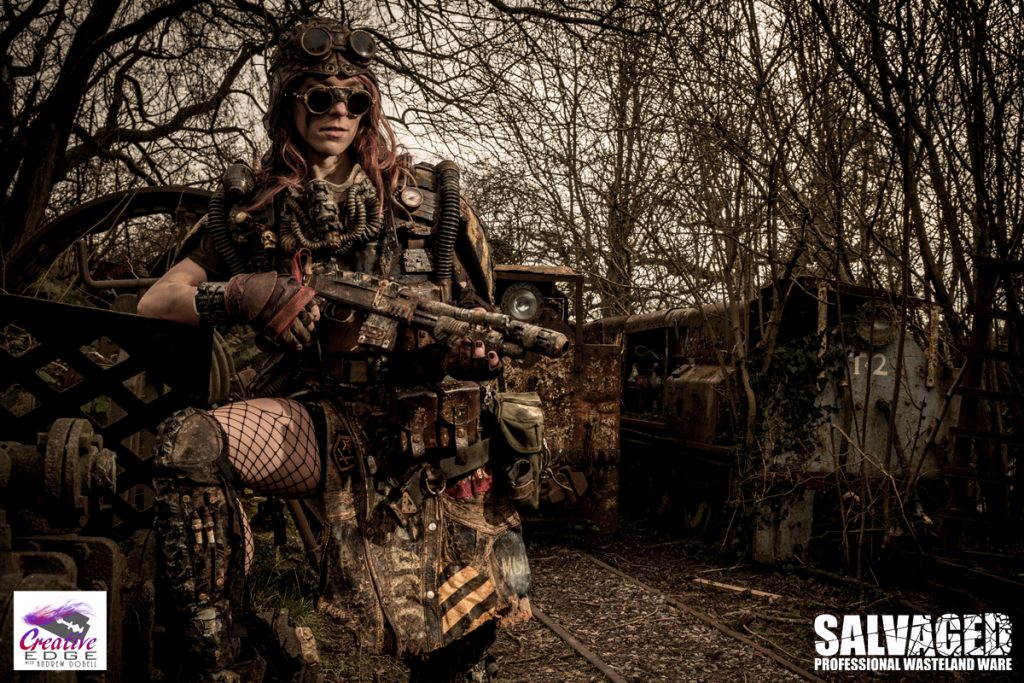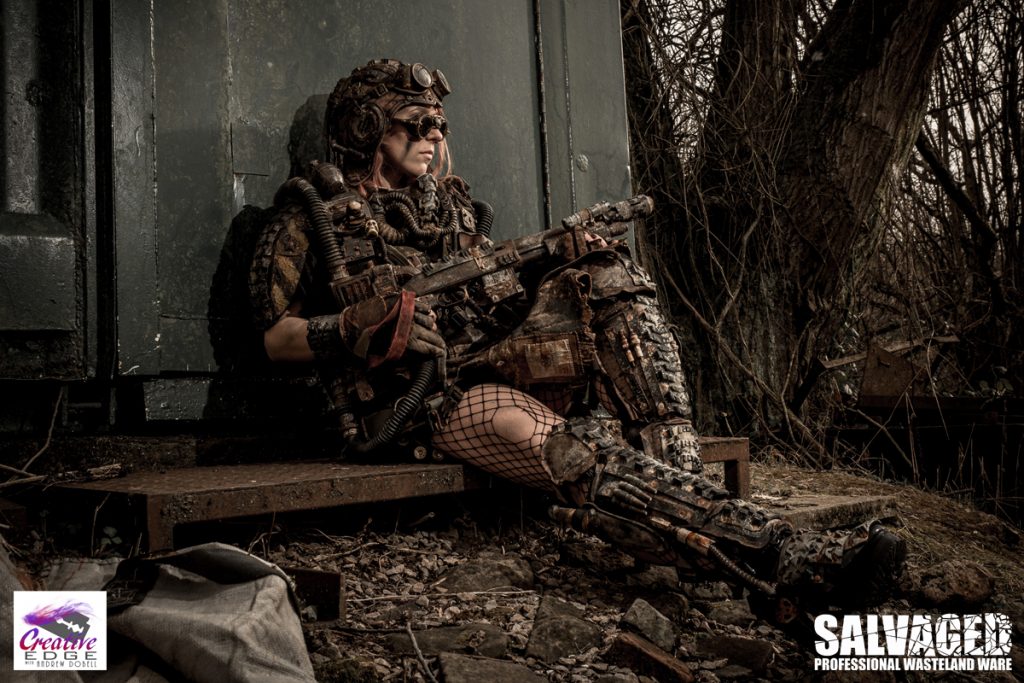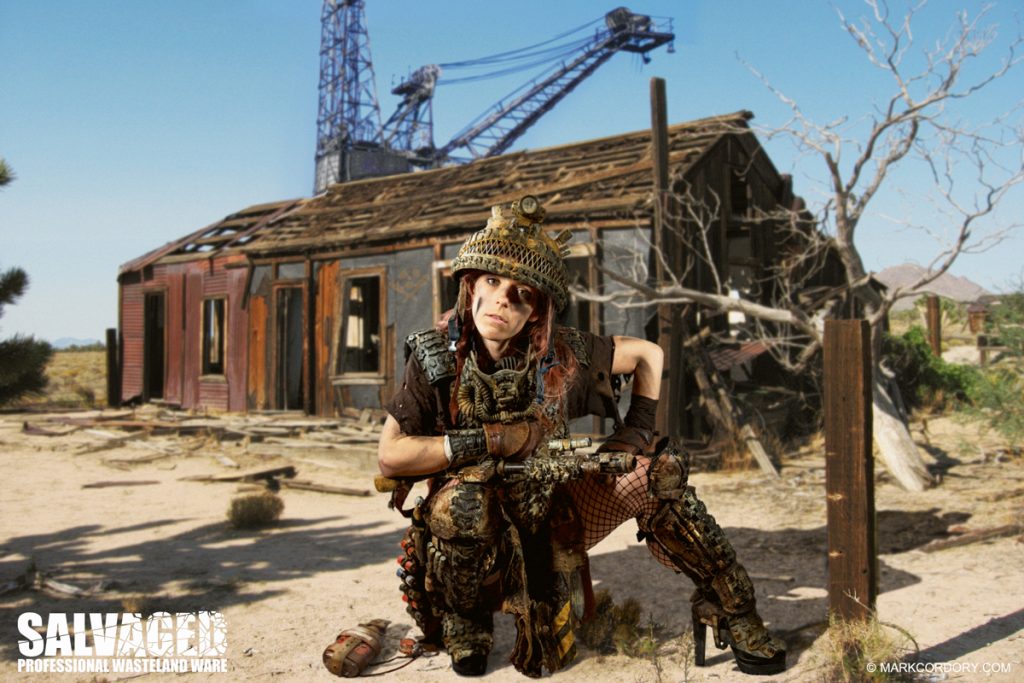His name may not be a household fixture just yet, but if you’re any fan of sci-fi or fantasy pop culture, you know his work. Mark Cordory has been making magic behind the TV, film, and music industry scenes for over 30 years now, but it’s his most recent incursion into the post-apocalyptic costuming scene that really caught our attention and the attention of the unwashed masses hungry for the genuine article during this tidal wave of popularity for the genre.

If you do a search for “post-apocalyptic costume” on Pinterest, you’ll notice that the top hits are usually Mark’s masterpieces (go ahead and look, we’ll wait). And this isn’t a coincidence. Mark’s talent, combined with his experience and awareness of current trends, has driven him straight to the top.
I was honored to chat with Mark about his work, for one, because I’m a big fan of Torchwood and Doctor Who in general. Mark worked on props for both Torchwood and the Doctor Who TV series from 2005 to 2007, in what he modestly describes as an extra dash of luck. “Obviously as someone who grew up watching Doctor Who through the ’70s and ’80s I’m immensely proud to have been able to work on the production when it returned to our screens with Christopher Eccleston and later David Tennant,” Mark said. “I was fortunate enough to be working in the right industry in the right city at the right time and when I heard it was returning I was determined to be involved. The fact that I ended up running a whole department for the production will always be a matter of pride and I think we did some great stuff with remarkably limited facilities.”
Mark has always been interested in the artistic side of life, although it wasn’t a simple or easy path growing up in the UK. “Art classes were always my strong point throughout school and so once I left I was always going to try to find a degree course that was artistically based,” he recalled. “Back in the late ’70s, early ’80s there wasn’t really much choice in the UK for courses that provided any specific inroad into TV and film work, though. Theatre Design was pretty much the main option, so that’s what I chose. However, since graduating I’ve worked pretty much full time in the TV and film industries in the UK until I took a conscious decision a few years ago to cut down my workload in that area. But during that time I’ve been fortunate enough to work on some fantastic productions.”
And those production are indeed quite fantastic, spanning everything from children’s puppets to a heavy metal icon. “I guess a lot of things I’ve worked on will only really be known to those who’ve grown up in the UK,” Mark pointed out. “But among the most notable were probably designing and sculpting the dragon ‘Smirkenorff’ for the popular UK TV series Knightmare (a UK children’s game show that utilised really early blue screen, puppets, and computer graphics which ran from 1987 to 1994). I’d also add working as a props maker on the BBC series Maid Marian and Her Merry Men and Tim Burton’s The Corpse Bride, and designing and building Eddie for Iron Maiden’s Fear of the Dark album and tour. And, of course, being Head of Dept for Props Fabrication for the Eccleston and early Tennant era of Doctor Who and Torchwood.”
But Mark isn’t only proud of his professional industry work, he’s also pleased with his freelance creations, including his “The Scourge” pirate goblin puppet that currently acts as his company logo, as well as his post-apocalyptic LARP kit. In fact, Mark is an avid LARPer, having enjoyed what he calls “an abiding passion” for over 35 years now.
Mark started Mythlore LARP back in 1985 and continues to create some amazing costumes, props, and scenic FX for all genres of LARP events all across the UK. Sometimes it’s these individual projects that really keep Mark’s creativity flowing. “I guess you could call pieces like these ‘vanity projects’ or indulgences, but sometimes it’s good not to be constrained by things like budgets and to really let yourself experiment since the things you learn in the process will always feed back into your regular work and help improve it so everyone benefits in the end.”

But it’s that distinct Mark Cordory style that really makes all of his creations stand out. The attention to detail, the application and realization of what real weathering looks like, and the variation of materials all come together to make truly inspirational pieces. “There are a lot of talented crafters out there in the post-apocalyptic genre and it’s a constant drive for me to ensure my own work remains recognisable and distinct from other peoples,” he admits. “…Especially since this isn’t just a hobby or a job that’s in addition to an existing wage. I need to make my living off designing and making props and costumes both for industry jobs and private clients, so I need to make it worth while for clients to choose me over all the other crafters and makers out there who are also producing great pieces. I think we all have our own approaches, and mine’s certainly informed by my experiences within the industry. You pick up tips and techniques that maybe aren’t widely known, certain ways of using materials and little things that you can build on and develop into different approaches to finishes, etc.”
While Mark acknowledges the hundreds of helpful online tutorials for post-apocalyptic propmaking, he stresses the importance of trying something different. “Personally, I specifically try to avoid some of the more common techniques since they create a very specific finish. Concrete, for example, is often used for dust ageing but I try to avoid using it if at all possible simply because I want to try to make my work look different. There’s no right or wrong approach to designing or ageing items or kit, but as I said, I’m constantly experimenting and working to develop new techniques to try to make my own pieces stand out in terms of style and finishes. I’d hate to think that everyone’s work eventually looked the same because we all took the same approach to designing and ageing our work.”
Of course, Mark’s work wasn’t always so refined. “The great thing about my business is that there’s rarely ever an instruction manual for what you’re making, every job poses new challenges and requires new approaches if you’re going to get the best out of it. My techniques have changed beyond all recognition from when I first started, and yet at the same time many are still based upon skills I learned early on in my career, you just keep pushing them and adapting them and trying new things with them.
“Back when I was first training I was given the task of ageing items that I’d made and the idea of breaking down these things that had taken me days or possibly weeks to make felt like sacrilege, but now, years later, the whole process of ageing and distressing items is quite possibly the most enjoyable part of the creative process for me, especially when it’s applied to my post-apocalyptic work.”

It’s this unique approach to his work that inspired Mark’s new SALVAGED line of costumes made specifically for post-apocalyptic fans. “Initially, the post apocalyptic work was only a fraction of my work output, but as it increased I realised I needed to ‘brand’ it beyond just my name, and the SALVAGED title just seemed to sum up the way I was working: taking old discarded items and re-purposing them into something new. […]But it’s rapidly become my main passion and I think I get the most pleasure out of making kits for this genre.”
Mark also jokes about the importance of truly repurposing materials, which is perfect for this style. “I also like to think it’s a little bit of payback for my years in an industry that generates quite so much landfill and waste. Many of the materials we use like fibreglass and polystyrene will be sitting in landfill for generations to come, but now I’m taking things that would’ve otherwise just ended up there and giving them a new lease of life. It’s a small spit in the ocean I know, but it feels better than filling up a skip every couple of weeks.
“But in all honesty, SALVAGED has come about simply because I love the work and want to do more of it and thankfully it’s leading to some really interesting commissions and collaborations. In 2016 I launched the SALVAGED line and got some lovely commissions including being invited over to work on a post-apocalyptic escape room in France. This year I’m collaborating with festival organisers, musicians and bands, film producers, new escape rooms and LARP groups and it’s all post apocalyptic work, it just seems to keep growing. I’m also appearing at the large SciFi Weekender convention in the UK in March as part of the Doctor Who panel but I’ll be trading there too. There’ll be a few Doctor Who themed pieces but predominantly it’s going to be my PA work.”
Mark also offers practical advice for those looking to get into an industry that works almost exclusively with plastics, rubbers, and paints. “One important thing I would say though is to always make sure you have a good health and safety regime. Always wear appropriate filter masks and eye protection whenever necessary. Use processes and materials sensibly. I can’t stress this enough: you only get one set of lungs and eyes, make sure you keep them!”
Be sure to check out Mark’s portfolio on his website, his Pinterest account, and find out more about him and his professional experience on his IMDb profile. You can find Creative Edge Studios at https://www.creativeedgestudios.co.uk
Interview originally published on January 9, 2017 at aftermathevent.com.


Leave a Reply